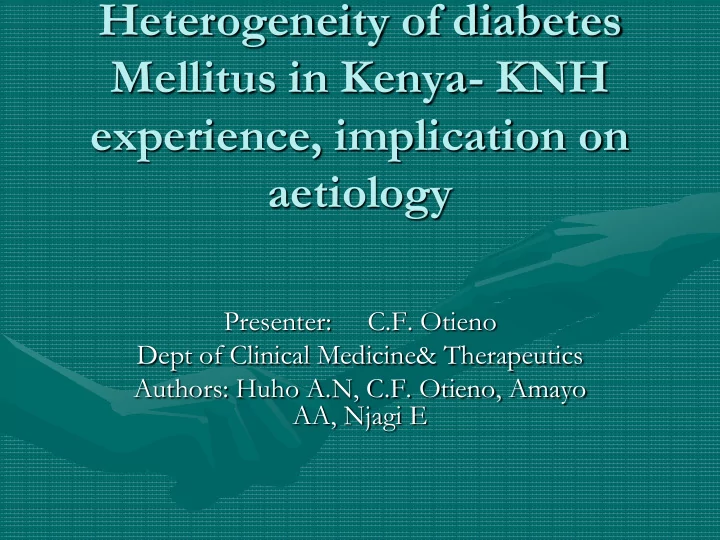

Heterogeneity of diabetes Mellitus in Kenya- KNH experience, implication on aetiology Presenter: C.F. Otieno Dept of Clinical Medicine& Therapeutics Authors: Huho A.N, C.F. Otieno, Amayo AA, Njagi E
INTRODUCTION • Type 1&2 diabetes suffer beta cell failure, by apoptosis • Type 1 diabetes, beta cell mass loss of 70-80%, by “insulitis” • Type 2 diabetes, beta cell mass loss by 25-50% or more at diagnosis.
Risk Factors of Diabetes • Genetics • Environmental factors e.g. diet • Obesity
Objective of Study • To determine the aetiological types of clinically classified ambulatory patients with diabetes mellitus
Patients and Methods • Patients with clinical type 1 & 2 diabetes • Serum assay of: Fasting C-Peptide; GAD auto- antibody titres and other biochemical tests.
Results • 184 subjects enrolled; 60 subjects with type 1 diabetes 64 subjects with overweight type 2DM 60 subjects with non-obese type 2DM • Socio-demographic characteristics of study subjects
General Characteristics of patients by clinical category Type 1 Non Obese Type 2 Obese Type 2 Female% 51.6% 46.6% 54.6% Age (yr) 16.7 (4.7) 47.2(13.2) 47.6(10.5) Mean (SD) Age at Diagnosis (yrs) 13.5(4.6) 45.1(13.2) 45.1(10.3) Mean (SD) Duration in months since diagnosis 33.43(19.8) 25.04(21.7) 29.63(19.9) Mean (SD) BMI Kg/m 2 19.44(3.0) 22.45(2.4) 29.83(3.4) Mean (SD) Fasting Blood glucose 11.52(5.4) 8.09(4.4) 8.17(4.8) mmol/l Mean (SD) Current therapy % Insulin 90% 41.7% 25.4% Insulin+OHA 6.7% 10% 14.3% OHA 0 38.3% 54% Diet 3.3% 10% 6.3% Positive Family History of diabetes 1 st Degree relatives % 2 nd Degree relatives % 13.3% 43.3% 40.6% 28.3% 8.3% 6.3%
BMI Patterns Clinical Types BMI Kg/m 2 * Type 1 Type 2 Total n(%) N(%) BMI ≤ 25 BMI > 25 N(%) N(%) <18.5 13(22%) 2(3.3% 0 154(8%) 18.5-24.9 44(73%) 58(96.6%) 0 102(55%) 25-29.9 3(5%) 0 36(56%) 39(21%) 27(15%) >40 0 0 27(42%) 1(0.5%) 0 0 1(2%) 184(100%) Total 60(100%) 60(100%) 64(100%)
GADA STATUS 90 80 70 60 50 GADA + VE GADA GADA -VE 40 30 20 10 0
CHARACTERISTICS OF GADA POSITIVE AND GADA NEGATIVE SUBJECTS GADA POSITIVE GADA P Values NEGATIVE N=36 N=148 Mean age (yr) 27.6 39.6 <0.001 Mean HBAIC % 9.6 9.05 <0.001 Mean duration in 28.5 30.14 0.32 months since diagnosis Mean BMI 20.7 24.7 <0.001 Mean fasting blood 11.8 8.62 <0.001 Glucose mmol/l
Aetiological classification Type 2 Type 1A Type 1B LADA Total “classical” Clinical 25 33 0 2 100% Type 1 a 41.66% 55% 0 3.3% (n=60) Clinical 4 13 4 39 100% Type 2 6.66% 21.66% 6.66% 65% BMI ≤ 25 b (n=60) Clinical 0 2 3 59 100% Type 0% 3.12% 4.69% 92.18% 2 BMI >25 b ((n=64)
Summary • The patients with DM attending the clinic are heterogeneous: Type 1A & B Type LADA Type 2 – “Classical” “youth” • Diverse aetiological background- environmental, genetic, obesity
Conclusion • Aetiological background of diabetes similar to findings of other regions in the world • However proportions of the various types may be different • The heterogeneity of clinical diabetes has implications on therapeutic choices • Further studies need to be done locally to elucidate unique factors that precipitate diabetes locally
Recommend
More recommend